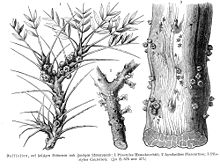| Apodanthaceae | |
|---|---|

| |
| Scientific classification | |
| Kingdom: | Plantae |
| Clade: | Tracheophytes |
| Clade: | Angiosperms |
| Clade: | Eudicots |
| Clade: | Rosids |
| Order: | Cucurbitales |
| Family: | Apodanthaceae Tiegh. ex Takht. |
| Genera | |
The family Apodanthaceae comprises about 10 species of endoparasitic herbs. They live in the branches or stems of their hosts (as filaments similar to a fungal mycelium), emerging only to flower and fruit. The plants produce no green parts and do not carry out any photosynthesis (that is, they are holoparasitic). There are two genera: Pilostyles and Apodanthes. A third genus, Berlinianche, was never validly published.
The native range of Apodanthes is restricted to Central and tropical South America, while Pilostyles has a much wider though disjointed native range, encompassing many countries in tropical and subtropical America, a section of Africa from Gabon to Tanzania and down to Zimbabwe, as well as Turkey, Iran, Iraq, and Western Australia.
Taxonomy
The relationship of the Apodanthaceae to other plant families remains unresolved, though recent research has given more clarity to the family's position and suggests inclusion in the order Malpighiales with a possible link to the family Rafflesiaceae.
While the APG III system of classification (2009) listed the family's taxonomic position as uncertain, the APG IV update in 2016 assigned it to the Cucurbitales based on mitochondrial and nuclear DNA sequences. However, two 2024 studies, both of which use large sets of nuclear DNA for analysis, indicate that it is a basal member of the Malpighiales.
The difficulty with using plastid DNA for phylogenetics of the Apodanthaceae was discussed in a 2021 study by Li et al. This paper refers to the Apodanthaceae as one of five 'problematic' families (along with Balanophoraceae, Mitrastemonaceae, Rafflesiaceae, and Thismiaceae) and notes that plastome sequences in these families are highly reduced and they have unusually high substitution rates in the retained sequences, which can hamper proper phylogenetic alignment and cause long branch attraction artifacts.
External links
References
- Christenhusz, M. J. M. & Byng, J. W. (2016). "The number of known plants species in the world and its annual increase". Phytotaxa. 261 (3). Magnolia Press: 201–217. doi:10.11646/phytotaxa.261.3.1.
- Albert Blarer, Daniel L. Nickrent, and Peter K. Endress. 2004. "Comparative floral structure and systematics in Apodanthaceae (Rafflesiales)". Plant Systematics and Evolution 245(1-2):119-142.
- Bellot, S., and S. S. Renner. 2013. "Pollination and mating systems of Apodanthaceae and the distribution of reproductive traits in parasitic angiosperms". "American Journal of Botany" 100(6): 1083–1094.
- "Apodanthes Poit. | Plants of the World Online | Kew Science". Plants of the World Online. Retrieved 2024-02-28.
- "Pilostyles Guill. | Plants of the World Online | Kew Science". Plants of the World Online. Retrieved 2024-02-28.
- Stevens, Peter F. (2001), Angiosperm Phylogeny Website - Malpighiales
- Angiosperm Phylogeny Group (2009). "An update of the Angiosperm Phylogeny Group classification for the orders and families of flowering plants: APG III". Botanical Journal of the Linnean Society. 161 (2): 105–121. doi:10.1111/j.1095-8339.2009.00996.x. hdl:10654/18083.
- Angiosperm Phylogeny Group (2016). "An update of the Angiosperm Phylogeny Group classification for the orders and families of flowering plants: APG IV". Botanical Journal of the Linnean Society. 181 (1): 1–20. doi:10.1111/boj.12385.
- Filipowicz, N., and S. S. Renner. 2010. "The worldwide holoparasitic Apodanthaceae confidently placed in the Cucurbitales by nuclear and mitochondrial gene trees." BMC Evolutionary Biology 10:219
- Zuntini, Alexandre R.; Carruthers, Tom; Maurin, Olivier; Bailey, Paul C.; Leempoel, Kevin; Brewer, Grace E.; et al. (24 April 2024). "Phylogenomics and the rise of the angiosperms". Nature. 629 (8013): 843–850. Bibcode:2024Natur.629..843Z. doi:10.1038/s41586-024-07324-0. ISSN 0028-0836. PMC 11111409. PMID 38658746.
- Alzate JF, González FA, Pabón-Mora N (December 2024). "Back together: Over 1000 single-copy nuclear loci and reproductive features support the holoendoparasitic Apodanthaceae and Rafflesiaceae as sister lineages in the order Malpighiales". Mol Phylogenet Evol. 201: 108217. Bibcode:2024MolPE.20108217A. doi:10.1016/j.ympev.2024.108217. PMID 39384124.
- Li HT, Luo Y, Gan L, Ma PF, Gao LM, Yang JB, Cai J, Gitzendanner MA, Fritsch PW, Zhang T, Jin JJ, Zeng CX, Wang H, Yu WB, Zhang R, van der Bank M, Olmstead RG, Hollingsworth PM, Chase MW, Soltis DE, Soltis PS, Yi TS, Li DZ (October 2021). "Plastid phylogenomic insights into relationships of all flowering plant families". BMC Biol. 19 (1): 232. doi:10.1186/s12915-021-01166-2. PMC 8555322. PMID 34711223.
| Taxon identifiers | |
|---|---|
| Apodanthaceae |
|